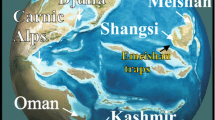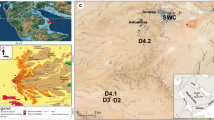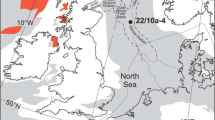Abstract
Authigenic kaolinite and illite are important diagenetic minerals in the Magnus Sandstone, a giant oil reservoir in the northern North Sea. These clay minerals, separated from three wells, show considerable ranges in their oxygen isotopic composition (δ8OSMOW = +9 to + 16%) and hydrogen isotopic composition (δDSMOW = - 55 to - 105%). The variations in δ18O and δD are positively linearly correlated with a high degree of statistical significance for both kaolinite and illite:
\(\begin{array}{c}{\rm{Kaolinite}}:\;\;{\rm{n}}=12;\;\;\;{\rm{\delta}D}=6.1\;\;{\rm{{\delta}}^{18}}{\rm{O}}-169;\;\;\;{\rm{r}}=0.66(>95\%)\\ {\rm{Illite}}:\;\;\;\;\;{\rm{n}}=11;\;\;\;\;\;\;{\rm{\delta}D}=5.9\;\;\;{\rm{{\delta}}^{18}}{\rm{O}}-159;\;\;\;{\rm{r}}=0.78(>99\%).\end{array}\)
Formation of the clays in a pore fluid of uniform isotopic composition over a range of temperatures appears unlikely. It is suggested that the observed relationships between clay mineral δ18O and δD are perhaps best explained by a model of precipitation at more or less constant temperature from pore fluids which varied isotopically across the oilfield. The isotopic composition of the formation waters would then lie along the line: δDw = 6.2 δl8Ow - 50. This is most plausibly interpreted as a mixing line with suggested minimal endmembers at (δ18O, δD) values of (+4, -24) and (-4, -76). The first of these represents reasonable isotopic values for Magnus Sandstone formation waters. Although δ18O of the second is compatible with an evolved Cretaceous meteoric water, its δD value is difficult to understand in the context of the model.
Similar content being viewed by others
References
Aplin, A. C., Warren, E. A., and Grant, S. M. (1992) Mechanism of quartz cementation in North Sea reservoir sands: Constraints from fluid compositions: Bull. A.A.P.G. (submitted).
Borthwick, J. and Harmon, R. S. (1982) A note regarding ClF3 as an alternative to BrF5 for oxygen isotope analysis: Geochim. Cosmochim. Acta 46, 1665–1668.
Carstens, H. and Finstad, K. G. (1981) Geothermal gradients of the northern North Sea Basin, 59-62°N: in Petroleum Geology of the Continental Shelf of North West Europe, L. V. Illing and G. D. Hobson, eds., Heyden and Son, London, 152–161.
Clayton, R. N. and Mayeda, T. K. (1963) The use of bromine pentafluoride in the extraction of oxygen from oxides and silicates for isotopic analysis: Geochim. Cosmochim. Acta 27, 43–52.
Coleman, M. L. (1992) Intra-field variations in formation waters: in The Chemistry and Origins of North Sea Formation Waters: Implications for Diagenesis and Production Chemistry, Geological Society, London.
Craig, H. (1961) Isotopic variations in meteoric waters: Science 133, 1702–1703.
De’Ath, N. G. and Schuyleman, S. F. (1981) The geology of the Magnus Oilfield: in Petroleum Geology of the Continental Shelf of North West Europe, L. V. Illing and G. D. Hobson, eds., Heyden and Son, London, 342–351.
Eberl, D. D., Srodon, J., Kralik, M., Taylor, B. E., and Peterman, Z. E. (1990) Ostwald ripening of clays and meta-morphic minerals: Science 248, 474–477.
Egeberg, P. K. and Aagaard, P. (1989) Origin and evolution of formation waters from oilfields on the Norwegian shelf: App. Geochem. 4, 131–142.
Emery, D., Myers, K. J., and Young, R. (1990a) Ancient subaerial exposure and freshwater leaching in sandstones: Geology 18, 1178–1181.
Emery, D., Robinson, A. G., Smalley, P. C., Fallick, A. E., and Clayton, T. (1990b) Morphological and isotopic evidence for multiple kaolinite generation in Brent group sandstones (Abs): Geol. Soc. Lond. Newsletter 19, 31.
Fallick, A. E., Jocelyn, J., Guy, M., Donnelly, T., and Behan, C. (1985) Origin of agates in volcanic rocks from Scotland: Nature 313, 672–674.
Forester, R. W. and Taylor, H. P. (1977) 18O/16O, D/H, and 13C/12C studies of the Tertiary igneous complex of Skye, Scotland: Am. J. Sci. 277, 136–177.
Glasmann, J. R., Lundegard, P. D., Clark, R. A., Penny, B. K., and Collins, I. D. (1989) Geochemical evidence for the history of diagenesis and fluid migration: Brent sandstone, Heather Field, North Sea: Clay Miner. 24, 255–284.
Hamilton, P. J., Fallick, A. E., Macintyre, R. M., and Elliot, S. (1987) Isotopic tracing of the provenance and diagenesis of Lower Brent Group sandstones, North Sea: in Petroleum Geology of North West Europe, J. Brooks and K. Glennie, eds., Graham and Trotman, London, 939–949.
Hamilton, P. J., Giles, M. R., and Ainsworth, P. (1992) K-Ar dating of illites in Brent Group reservoirs: A regional perspective: in Geology of the Brent Group, A. C. Morton, R. S. Haszeldine, M. R. Giles, and S. Brown, eds., Geological Society Special Publication No. 61, The Geological Society, London, 377–400.
Jackson, M. L. (1956) Soil Chemical Analysis—Advanced Course: Department of Soil Science, University of Wisconsin, Madison.
Jackson, M. L. (1979) Soil Chemical Analyses—Advanced Course 2nd Edition: Published by the author, Department of Soil Science, University of Wisconsin, Madison, 895p.
Kantorowicz, J. D. (1990) The influence of variations in illite morphology on the permeability of middle Jurassic Brent group sandstones, Cormorant Field, UK North Sea: Marine and Petrol. Geol. 7, 66–74.
Knauth, L. P. and Epstein, S. (1976) Hydrogen and oxygen isotope ratios in nodular and bedded cherts: Geochim. Cosmochim. Acta 40, 1095–1108.
Lee, M., Aronson, J. L., and Savin, S. M. (1985) K/Ar dating of time of gas emplacement in Rotliegendes Sandstone, Netherlands: Bull. AAPG 69, 1381–1385.
Lee, M., Aronson, J. L., and Savin, S. M. (1989) Timing and conditions of Permian Rotliegende sandstone diagenesis, southern North Sea: K/Ar and oxygen isotopic data: Bull. AAPG 73, 195–215.
Longstaffe, F. J. and Ayalon, A. (1990) Hydrogen-isotope geochemistry of diagenetic clay minerals from Cretaceous sandstones, Alberta, Canada: Evidence for exchange: App. Geochem. 5, 657–668.
Macaulay, C. I., Haszeldine, R. S., and Fallick, A. E. (1992a) Diagenetic pore waters stratified for at least 35 million years: Magnus Oilfield, North Sea: Bull. AAPG 76, 1625–1634.
Macaulay, C. I., Haszeldine, R. S., and Fallick, A. E. (1992b). Textural and isotopic variations in diagenetic kaolinite from the Magnus Oilfield sandstones: Clay Miner. (submitted.)
Macaulay, C. I., Haszeldine, R. S., and Fallick, A. E. (1993) Distribution, chemistry, isotopic composition and origin of diagenetic carbonates: Magnus sandstone, North Sea: J. Sed. Pet. 63, 33–43.
McHardy, W. J., Wilson, M. J., and Tait, J. M. (1982) Electron microscope and X-ray diffraction studies of filamentous illitic clay from sandstones of the Magnus field: Clay Miner. 17, 23–29.
Mehra, O. P. and Jackson, M. L. (1960) Iron oxide removal from soils and clays by a dithionite-citrate system buffered by sodium bicarbonate; in Clays and Clay Miner., Proc. 7th Conf, Nat. Acad. Sci., Natl. Res. Council Pub., 317–327.
O’Neil, J. R. and Kharaka, Y. K. (1976) Hydrogen and oxygen isotope exchange reactions between clay minerals and water: Geochim. Cosmochim. Acta 40, 241–246.
O’Neil, J. R. (1986) Theoretical and experimental aspects of isotopic fractionation: Rev. Mineral. 16, 1–40.
Savin, S. M. and Lee, M. (1988) Isotopic studies of phyl-losilicates: Rev. Mineral. 19, 189–224.
Shepherd, M. (1991) The Magnus field, blocks 21 l/7a, 12a, U.K. North Sea: in United Kingdom Oil and Gas Fields 25 Years Commemorative Volume, I. L. Abbotts, ed. Geological Society Memoir No. 14, The Geological Society, London, 153–157.
Sheppard, S. M. F. (1986) Characterization and isotopic variations in natural waters: Rev. Mineral. 16, 165–183.
Wilson, M. R., Kyser, T. K., Mehnert, H. H., and Hoeve, J. (1987) Changes in the H-O-Ar isotope composition of clays during retrograde alteration: Geochim. Cosmochim. Acta 51, 869–878.
Author information
Authors and Affiliations
Rights and permissions
About this article
Cite this article
Fallick, A.E., Macaulay, C.I. & Haszeldine, R.S. Implications of Linearly Correlated Oxygen and Hydrogen Isotopic Compositions for Kaolinite and Illite in the Magnus Sandstone, North Sea. Clays Clay Miner. 41, 184–190 (1993). https://doi.org/10.1346/CCMN.1993.0410207
Received:
Accepted:
Published:
Issue Date:
DOI: https://doi.org/10.1346/CCMN.1993.0410207




